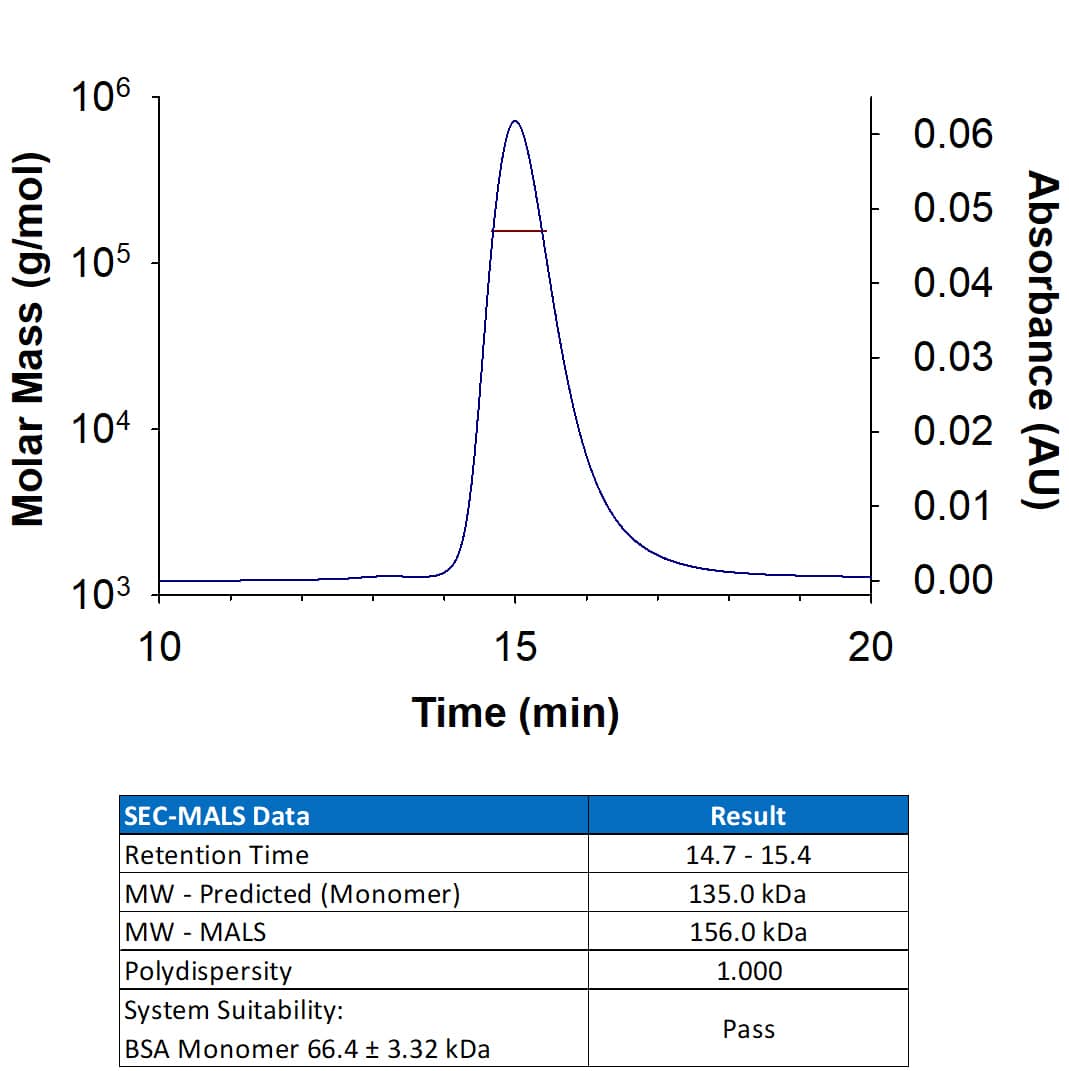Recombinant Human Plexin A1 His-tag Protein, CF
R&D Systems, part of Bio-Techne | Catalog # 10167-PA
Analyzed by SEC-MALS

Key Product Details
Product Specifications
Source
Human embryonic kidney cell, HEK293-derived human Plexin A1 protein
Glu27 - Pro1244, with a C-terminal 6-His tag
Glu27 - Pro1244, with a C-terminal 6-His tag
Purity
>95%, by SDS-PAGE visualized with Silver Staining and quantitative densitometry by Coomassie® Blue Staining.
Endotoxin Level
<0.10 EU per 1 μg of the protein by the LAL method.
N-terminal Sequence Analysis
Glu27
Predicted Molecular Mass
135 kDa
SDS-PAGE
130-150 kDa, under reducing conditions
Activity
Measured by its binding ability in a functional ELISA.
When Recombinant Human Plexin A1 His-tag is immobilized at 2.50 µg/mL (100 µL/well), Recombinant Human Semaphorin 6C Fc Chimera (Catalog # 2219-S6) binds with an ED50 of 1.00-6.00 μg/mL.
When Recombinant Human Plexin A1 His-tag is immobilized at 2.50 µg/mL (100 µL/well), Recombinant Human Semaphorin 6C Fc Chimera (Catalog # 2219-S6) binds with an ED50 of 1.00-6.00 μg/mL.
Scientific Data Images for Recombinant Human Plexin A1 His-tag Protein, CF
Recombinant Human Plexin A1 His-tag Protein SEC-MALS.
Recombinant Human PLXNA-1/C-His (Catalog # 10167-PA) has a molecular weight (MW) of 156.0 kDa as analyzed by SEC-MALS, suggesting that this protein is a monomer. MW may differ from predicted MW due to post-translational modifications (PTMs) present (i.e. Glycosylation).Recombinant Human Plexin A1 His-tag Protein SDS-PAGE.
2 μg/lane of Recombinant Human Plexin A1 His-tag (Catalog # 10167-PA) was resolved with SDS-PAGE under reducing (R) and non-reducing (NR) conditions and visualized by Coomassie® Blue staining, showing bands at 130-150 kDa...Formulation, Preparation and Storage
10167-PA
| Formulation | Supplied as a 0.2 μm filtered solution in PBS. |
| Shipping | The product is shipped with dry ice or equivalent. Upon receipt, store it immediately at the temperature recommended below. |
| Stability & Storage | Use a manual defrost freezer and avoid repeated freeze-thaw cycles.
|
Background: Plexin A1
References
- Kameyama, T. et al. (1996) Biochem. Biophys. Res. Commun. 226:524.
- Kruger, R.P. et al. (2005) Nat. Rev. Mol. Cell Biol. 6:789.
- Takamatsu, H. et al. (2010) Cell. Mol. Immunol. 7:83.
- O’Connor, B.P. and J.P.Y. Ting (2008) Immunol. Res. 41:217.
- Takahashi, T. et al. (1999) Cell 99:59.
- Yoshida, Y. et al. (2006) Neuron 52:775.
- Toyofuku, T. et al. (2005) Nat. Neurosci. 8:1712.
- Nawabi, H. et al. (2010) Genes Dev. 24:396.
- Eun, S-Y. et al. (2006) J. Immunol. 177:4271.
- Takegahara, N. et al. (2006) Nat. Cell Biol. 8:615.
- Watarai, H. et al. (2008) Proc. Natl. Acad. Sci. USA 105:2993.
- Catalano, A. et al. (2009) Cancer Res. 69:1485.
- Delloye-Bourgeois, C. et al. (2015) Nat Neurosci 18:36.
Alternate Names
NOVP, PLXN1, PLXNA1
Gene Symbol
PLXNA1
UniProt
Additional Plexin A1 Products
Product Documents for Recombinant Human Plexin A1 His-tag Protein, CF
Product Specific Notices for Recombinant Human Plexin A1 His-tag Protein, CF
For research use only
